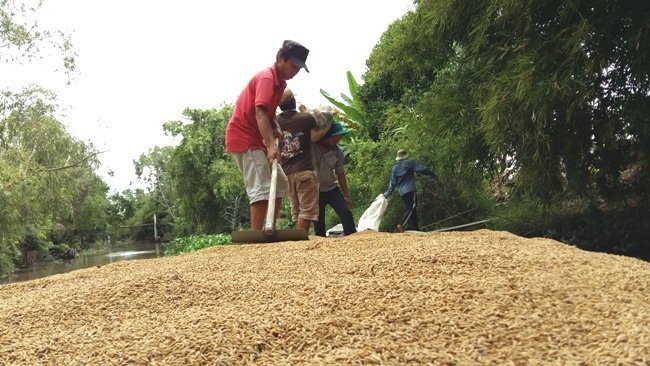Background:
Indochina Report (October 1984)
Part II: Vietnamization of the Economic Framework (continued)
The Unequal Exchange
It is within this new institutional framework that the Vietnamese are asserting their hold over the economy and future of Kampuchea. Fisheries, rubber and rice are the three main sectors affected by what should be termed the Unequal Exchange between Vietnam and Kampuchea.
Related:
សហព័ន្ធ ស្រូវអង្ករ កម្ពុជា សុំ អន្តរាគមន៍ ដោះស្រាយ វិបត្តិ ផលិតកម្ម និងទីផ្សារ | Cambodian Rice Federation requests intervention to resolve crisis of production, market
កសិករ និងក្រុមហ៊ុន នាំអង្ករចេញ បារម្ភ ពីគម្រោង វិនិយោគ ដាំស្រូវ របស់ វៀតណាម នៅកម្ពុជា | Farmers, rice exporting co. concerned about investment plan for Vietnam to grow rice in Cambodia
Commerce minister puts rice ball in Hun Sen’s court
Under Fire, Rice Federation Vows Action
ពលរដ្ឋ នៅតាម បណ្ដោយ ព្រំដែន បន្ត ជួលដី កសិកម្ម ឲ្យវៀតណាម | Villagers living along border continue to rent out farmland to Vietnam
. . .
Vietnam told to grow rice in Cambodia to export to the EU
VietNamNet Bridge - Vietnamese businesses are considering growing
rice in Cambodia for export to the EU, since the country enjoys preferential
policy in exporting farm produce to the market.
Vietnam Net Bridge | 10 March 2016
 |
| Vietnamese businesses are considering growing rice in Cambodia for export to the EU |
The
director of a rice export company said it was not difficult to grow high
quality rice and build a Vietnamese rice brand. But it was hard to find
buyers.
According to the Vietnam Food Association (VFA), Vietnam exports about 8 million tons of rice every year and China remains the biggest consumer.
Vietnam also sells rice to the Philippines, Indonesia and Malaysia in ASEAN, and markets such as Africa and South America.
The common characteristic of these markets is that they are easy to please and do not require high quality products.
According to the Vietnam Food Association (VFA), Vietnam exports about 8 million tons of rice every year and China remains the biggest consumer.
Vietnam also sells rice to the Philippines, Indonesia and Malaysia in ASEAN, and markets such as Africa and South America.
The common characteristic of these markets is that they are easy to please and do not require high quality products.
There are two choices for the businesses. They can either set up husking and processing rice plants in Cambodia, or organize production in Cambodia for export.
|
Meanwhile, it is very difficult for
Vietnamese businesses to penetrate the EU and US markets, which are more
demanding.
“We always meet obstacles when trying to enter the EU,” director of a rice export company said.
However, Cambodian exporters can sell rice to the European market. The EU is the biggest consumer of Cambodian rice.
Why can Cambodia sell rice to the EU, while Vietnam, the second largest rice exporter in the world, cannot?
According to the Commercial Affairs Division of the Vietnamese Embassy in Cambodia, Cambodian businessmen can export rice to the EU because they can enjoy preferences.
Under the EBA initiative (Everything But Arms) applied by the EU to poor countries like Cambodia, all the goods, except arms, exported to the EU can enjoy a preferential tariff of zero percent. Cambodia has been taking full advantage of the policy to export rice to the EU since 2010.
A report found that since 2013, Cambodia has exported 400,000 tons of rice every year, 62 percent of which goes to the EU.
Nguyen Bao from the Vietnamese Embassy in Cambodia suggested that Vietnam should grow rice in Cambodia to export to the EU to enjoy the preferences.
He said Cambodia now needs $300 million worth of capital to invest
in agriculture, which could be a great opportunity for Vietnamese businesses as
this would help them access the EU market.“We always meet obstacles when trying to enter the EU,” director of a rice export company said.
However, Cambodian exporters can sell rice to the European market. The EU is the biggest consumer of Cambodian rice.
Why can Cambodia sell rice to the EU, while Vietnam, the second largest rice exporter in the world, cannot?
According to the Commercial Affairs Division of the Vietnamese Embassy in Cambodia, Cambodian businessmen can export rice to the EU because they can enjoy preferences.
Under the EBA initiative (Everything But Arms) applied by the EU to poor countries like Cambodia, all the goods, except arms, exported to the EU can enjoy a preferential tariff of zero percent. Cambodia has been taking full advantage of the policy to export rice to the EU since 2010.
A report found that since 2013, Cambodia has exported 400,000 tons of rice every year, 62 percent of which goes to the EU.
Nguyen Bao from the Vietnamese Embassy in Cambodia suggested that Vietnam should grow rice in Cambodia to export to the EU to enjoy the preferences.
Thoi Bao Kinh Te Sai Gon quoted its sources as saying that some Vietnamese businesses are considering setting up their production and trade bases in Cambodia.
There are two choices for the businesses. They can either set up husking and processing rice plants in Cambodia, or organize production in Cambodia for export.
“We will have to ‘take a roundabout’. However, we will not have to worry about consumption,” the director of a business said.


ដល់ករតែម្តងហើយ ព្រៃឈើអស់ រ៉ែអស់ ឥឡុវដល់ពេលស្រូវ តើយួនចង្អុលហើយខ្មែរច្បាស់ជាបាស់សក់ហើយ គឹលើសពីដាំតែអុងទៅទៀត ខ្មែររីកចម្រើនណាស់ម្តងនេះ យួនមកធ្វើស្រែយកទៅលក់ឲ្យអឺរ៉ុប ហ៊ុន សែន ច្បាស់ជាដេញខ្មែរយកដីឲ្យយួនទៀតហើយ គេថា ចិនដេញខ្មែរ ខ្មែរដេញខ្មោច តែពេលនេះ យួនដេញខ្មែរ ខ្មែររកខ្មោចដេញមិនបានទេ គឺមានតែរត់ចោលស្រុក តើមានទេ? យួនថាឌូម៉ែ ខ្មែរជាន់ករគ្នាហើយ ឃើញទេយួនវាល្អណាស់មែនទេ?
ReplyDeleteម៉េចក៏ទៅជាអ៊ីចឹងវិញ? ក្រែង ហ៊ុនសែន គាត់ជាប្រធាន និងជា បិតា របស់ Organization of the Rice Exporting Countries (OREC) នោះអី?
ReplyDeleteគាត់មិនបណ្ដោយ ឲ្យខ្មែរពិបាកទេ !។ និយាយអាក្រក់ពីគាត់ អត់ខ្លាចគាត់ ខ្ញាល់ទេឬ !!!